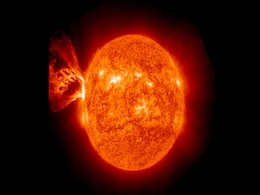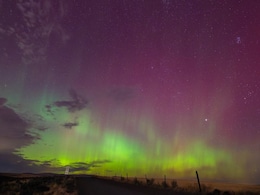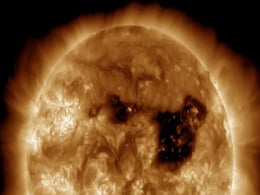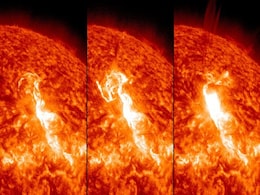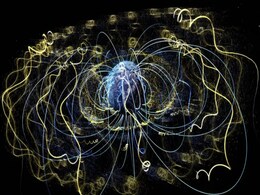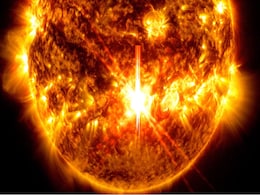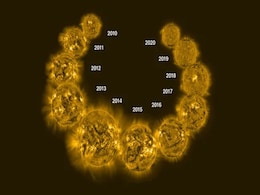Solar Storm Impact
- All
- News
- Videos
-

X-Class Solar Flare From Emerging Sunspot Causes Radio Blackouts
- Wednesday April 2, 2025
- Written by Gadgets 360 Staff
An unexpected X1.1-class solar flare erupted from sunspot AR4046, triggering shortwave radio blackouts over North and South America. The flare originated from the sun’s eastern limb and was accompanied by a coronal mass ejection that is not expected to impact Earth. Space weather experts have warned that the sunspot will face Earth in the coming ...
-
 www.gadgets360.com
www.gadgets360.com
-

Solar Storm to Trigger Northern Lights in US: Visibility, Timing & Impact
- Thursday March 6, 2025
- Written by Gadgets 360 Staff
A solar storm is expected to reach Earth tonight, potentially creating auroras visible as far south as New York and Idaho. The Space Weather Prediction Center (SWPC) of NOAA forecasts a G1-class geomagnetic storm, with a possibility of stronger G2 conditions. This may lead to disruptions in GPS and radio signals. The best time to witness the northe...
-
 www.gadgets360.com
www.gadgets360.com
-

Tiny Plasma Jets on Sun Identified as Key Drivers of Solar Wind
- Friday February 14, 2025
- Written by Gadgets 360 Staff
Observations from ESA’s Solar Orbiter have revealed that tiny plasma jets, known as picoflares, are responsible for both the fast and slow components of the solar wind. The discovery challenges previous assumptions that different mechanisms drive these solar wind types. With further research, scientists hope to refine space weather predictions, p...
-
 www.gadgets360.com
www.gadgets360.com
-

May 2024 Solar Storm Triggers Unusual Radiation Belts, Raising Space Safety Concerns
- Wednesday February 12, 2025
- Written by Gadgets 360 Staff
A significant solar storm in May 2024 led to the creation of two temporary radiation belts, detected by the CIRBE satellite in June. One belt contained high-energy electrons, while the other was rich in protons, a rare occurrence. While the electron belt dissipated in three months, the proton-dominated belt remains, potentially affecting space miss...
-
 www.gadgets360.com
www.gadgets360.com
-

Massive Coronal Hole on Sun Sends High-Speed Solar Wind Toward Earth
- Tuesday February 4, 2025
- Written by Gadgets 360 Staff
A giant 800,000 km coronal hole on the Sun is unleashing high-speed solar wind toward Earth, potentially triggering a G1 geomagnetic storm on January 31 and February 1. The NOAA has issued a watch, predicting enhanced auroras in higher latitudes. While G1 storms are minor, they can impact satellites and power grids. The storm’s intensity remains ...
-
 www.gadgets360.com
www.gadgets360.com
-

Massive 500,000-Mile Coronal Hole on the Sun Blasts Solar Wind Toward Earth
- Thursday January 30, 2025
- Written by Gadgets 360 Staff
A gigantic coronal hole, spanning 500,000 miles, has formed on the sun’s surface, allowing solar wind to escape at speeds of over 310 miles per second. Forecasts indicate that this solar wind may reach Earth by January 31, triggering a minor (G1) geomagnetic storm. While no severe impact is expected, the storm could enhance auroras at higher lati...
-
 www.gadgets360.com
www.gadgets360.com
-

Earth's Hidden 'Ignorosphere' Could Provide Insights into Auroras
- Thursday January 23, 2025
- Written by Gadgets 360 Staff
A new dataset developed by Japanese researchers from the University of Tokyo provides valuable insights into Earth's upper atmosphere, specifically the mesosphere. Spanning 19 years, the data sheds light on phenomena like auroras, gravity waves, and their connection to space weather. The study, published in Progress in Earth and Planetary Science, ...
-
 www.gadgets360.com
www.gadgets360.com
-

AI Enhances Northern Lights Classification and Geomagnetic Storm Forecasting
- Friday January 10, 2025
- Written by Gadgets 360 Staff
A breakthrough in auroral research, powered by artificial intelligence, has allowed scientists to classify over 700 million auroral images. This effort, using NASA's THEMIS dataset, will significantly enhance the prediction of geomagnetic storms, which can disrupt Earth's communication and security systems. Led by the University of New Hampshire, t...
-
 www.gadgets360.com
www.gadgets360.com
-

NASA's LEXI Mission Will Explore Earth’s Magnetic Shield from the Moon
- Monday January 13, 2025
- Written by Gadgets 360 Staff
NASA is preparing for the launch of the Lunar Environment Heliospheric X-ray Imager (LEXI) aboard Firefly Aerospace's Blue Ghost lander, scheduled for January 15. The mission will observe Earth’s magnetosphere, capturing X-ray images that reveal how the planet's magnetic shield reacts to solar wind. This project could improve predictions of geoma...
-
 www.gadgets360.com
www.gadgets360.com
-

Solar Cycle 25: How the Sun’s Peak Activity Will Impact Earth in 2025
- Saturday December 28, 2024
- Written by Gadgets 360 Staff
Solar Cycle 25 continues with high activity levels in 2025. Increased solar flares and geomagnetic storms are anticipated, with risks to satellite systems and power grids. Widespread auroras could also light up low-latitude skies. Partial solar eclipses are scheduled for March and September in select regions. Observations indicate strong solar phen...
-
 www.gadgets360.com
www.gadgets360.com
-

Top 10 Solar Flares of 2024: The Most Powerful Solar Events and Their Impact
- Wednesday December 25, 2024
- Written by Gadgets 360 Staff
The Sun experienced significant solar activity in 2024, with over 50 X-class solar flares recorded. These powerful flares, originating from active regions like AR 13664, were accompanied by coronal mass ejections (CMEs) that caused geomagnetic storms and spectacular auroras across the globe. Among the strongest flares was the X9.0 recorded on Octob...
-
 www.gadgets360.com
www.gadgets360.com
-

Solar 'Battle Zone' Could be Even Worse Than Solar Maximum, Experts Warn
- Friday December 6, 2024
- Written by Gadgets 360 Staff
Experts warn that the sun's next phase, the "battle zone," could result in increased geomagnetic activity, lasting until 2028. This period could bring heightened solar flares and coronal holes, which may cause disruptions to satellites in low-Earth orbit. Space weather experts, including Scott McIntosh from Lynker Space, have noted that this phase ...
-
 www.gadgets360.com
www.gadgets360.com
-

NOAA's GOES-19 Satellite Captures First Images of Solar Eruptions
- Friday October 25, 2024
- Written by Gadgets 360 Staff
NOAA's new Compact Coronagraph (CCOR-1), mounted on the GOES-19 satellite, has captured its first images of a solar storm. Launched on June 25, 2024, the satellite provides crucial data on coronal mass ejections (CMEs) from the sun. Unlike ground-based instruments, CCOR-1 offers uninterrupted views of the solar corona, aiding in early warnings of p...
-
 www.gadgets360.com
www.gadgets360.com
-

Solar Maximum Explained: Current Status and Future Expectations in 2024
- Monday October 21, 2024
- Written by Gadgets 360 Staff
Solar maximum is the peak of solar activity in an approximately 11-year cycle. Currently, we are experiencing the solar maximum of Solar Cycle 25, which could last until 2026. This phase is characterized by an increase in sunspots and solar flares, impacting Earth through geomagnetic storms that can disrupt satellites, power grids, and communicatio...
-
 www.gadgets360.com
www.gadgets360.com
-

Powerful Solar Storm Might Have Caused Widespread Auroras and Potential Disruptions, NOAA Says
- Monday October 14, 2024
- Written by Gadgets 360 Staff
A powerful G4-class solar storm, triggered by a coronal mass ejection from the sun, is causing breathtaking auroras in unusual regions. This geomagnetic event may disrupt power grids and communication systems while providing the chance for spectacular light displays across the northern half of the United States. The National Oceanic and Atmospheric...
-
 www.gadgets360.com
www.gadgets360.com
-

X-Class Solar Flare From Emerging Sunspot Causes Radio Blackouts
- Wednesday April 2, 2025
- Written by Gadgets 360 Staff
An unexpected X1.1-class solar flare erupted from sunspot AR4046, triggering shortwave radio blackouts over North and South America. The flare originated from the sun’s eastern limb and was accompanied by a coronal mass ejection that is not expected to impact Earth. Space weather experts have warned that the sunspot will face Earth in the coming ...
-
 www.gadgets360.com
www.gadgets360.com
-

Solar Storm to Trigger Northern Lights in US: Visibility, Timing & Impact
- Thursday March 6, 2025
- Written by Gadgets 360 Staff
A solar storm is expected to reach Earth tonight, potentially creating auroras visible as far south as New York and Idaho. The Space Weather Prediction Center (SWPC) of NOAA forecasts a G1-class geomagnetic storm, with a possibility of stronger G2 conditions. This may lead to disruptions in GPS and radio signals. The best time to witness the northe...
-
 www.gadgets360.com
www.gadgets360.com
-

Tiny Plasma Jets on Sun Identified as Key Drivers of Solar Wind
- Friday February 14, 2025
- Written by Gadgets 360 Staff
Observations from ESA’s Solar Orbiter have revealed that tiny plasma jets, known as picoflares, are responsible for both the fast and slow components of the solar wind. The discovery challenges previous assumptions that different mechanisms drive these solar wind types. With further research, scientists hope to refine space weather predictions, p...
-
 www.gadgets360.com
www.gadgets360.com
-

May 2024 Solar Storm Triggers Unusual Radiation Belts, Raising Space Safety Concerns
- Wednesday February 12, 2025
- Written by Gadgets 360 Staff
A significant solar storm in May 2024 led to the creation of two temporary radiation belts, detected by the CIRBE satellite in June. One belt contained high-energy electrons, while the other was rich in protons, a rare occurrence. While the electron belt dissipated in three months, the proton-dominated belt remains, potentially affecting space miss...
-
 www.gadgets360.com
www.gadgets360.com
-

Massive Coronal Hole on Sun Sends High-Speed Solar Wind Toward Earth
- Tuesday February 4, 2025
- Written by Gadgets 360 Staff
A giant 800,000 km coronal hole on the Sun is unleashing high-speed solar wind toward Earth, potentially triggering a G1 geomagnetic storm on January 31 and February 1. The NOAA has issued a watch, predicting enhanced auroras in higher latitudes. While G1 storms are minor, they can impact satellites and power grids. The storm’s intensity remains ...
-
 www.gadgets360.com
www.gadgets360.com
-

Massive 500,000-Mile Coronal Hole on the Sun Blasts Solar Wind Toward Earth
- Thursday January 30, 2025
- Written by Gadgets 360 Staff
A gigantic coronal hole, spanning 500,000 miles, has formed on the sun’s surface, allowing solar wind to escape at speeds of over 310 miles per second. Forecasts indicate that this solar wind may reach Earth by January 31, triggering a minor (G1) geomagnetic storm. While no severe impact is expected, the storm could enhance auroras at higher lati...
-
 www.gadgets360.com
www.gadgets360.com
-

Earth's Hidden 'Ignorosphere' Could Provide Insights into Auroras
- Thursday January 23, 2025
- Written by Gadgets 360 Staff
A new dataset developed by Japanese researchers from the University of Tokyo provides valuable insights into Earth's upper atmosphere, specifically the mesosphere. Spanning 19 years, the data sheds light on phenomena like auroras, gravity waves, and their connection to space weather. The study, published in Progress in Earth and Planetary Science, ...
-
 www.gadgets360.com
www.gadgets360.com
-

AI Enhances Northern Lights Classification and Geomagnetic Storm Forecasting
- Friday January 10, 2025
- Written by Gadgets 360 Staff
A breakthrough in auroral research, powered by artificial intelligence, has allowed scientists to classify over 700 million auroral images. This effort, using NASA's THEMIS dataset, will significantly enhance the prediction of geomagnetic storms, which can disrupt Earth's communication and security systems. Led by the University of New Hampshire, t...
-
 www.gadgets360.com
www.gadgets360.com
-

NASA's LEXI Mission Will Explore Earth’s Magnetic Shield from the Moon
- Monday January 13, 2025
- Written by Gadgets 360 Staff
NASA is preparing for the launch of the Lunar Environment Heliospheric X-ray Imager (LEXI) aboard Firefly Aerospace's Blue Ghost lander, scheduled for January 15. The mission will observe Earth’s magnetosphere, capturing X-ray images that reveal how the planet's magnetic shield reacts to solar wind. This project could improve predictions of geoma...
-
 www.gadgets360.com
www.gadgets360.com
-

Solar Cycle 25: How the Sun’s Peak Activity Will Impact Earth in 2025
- Saturday December 28, 2024
- Written by Gadgets 360 Staff
Solar Cycle 25 continues with high activity levels in 2025. Increased solar flares and geomagnetic storms are anticipated, with risks to satellite systems and power grids. Widespread auroras could also light up low-latitude skies. Partial solar eclipses are scheduled for March and September in select regions. Observations indicate strong solar phen...
-
 www.gadgets360.com
www.gadgets360.com
-

Top 10 Solar Flares of 2024: The Most Powerful Solar Events and Their Impact
- Wednesday December 25, 2024
- Written by Gadgets 360 Staff
The Sun experienced significant solar activity in 2024, with over 50 X-class solar flares recorded. These powerful flares, originating from active regions like AR 13664, were accompanied by coronal mass ejections (CMEs) that caused geomagnetic storms and spectacular auroras across the globe. Among the strongest flares was the X9.0 recorded on Octob...
-
 www.gadgets360.com
www.gadgets360.com
-

Solar 'Battle Zone' Could be Even Worse Than Solar Maximum, Experts Warn
- Friday December 6, 2024
- Written by Gadgets 360 Staff
Experts warn that the sun's next phase, the "battle zone," could result in increased geomagnetic activity, lasting until 2028. This period could bring heightened solar flares and coronal holes, which may cause disruptions to satellites in low-Earth orbit. Space weather experts, including Scott McIntosh from Lynker Space, have noted that this phase ...
-
 www.gadgets360.com
www.gadgets360.com
-

NOAA's GOES-19 Satellite Captures First Images of Solar Eruptions
- Friday October 25, 2024
- Written by Gadgets 360 Staff
NOAA's new Compact Coronagraph (CCOR-1), mounted on the GOES-19 satellite, has captured its first images of a solar storm. Launched on June 25, 2024, the satellite provides crucial data on coronal mass ejections (CMEs) from the sun. Unlike ground-based instruments, CCOR-1 offers uninterrupted views of the solar corona, aiding in early warnings of p...
-
 www.gadgets360.com
www.gadgets360.com
-

Solar Maximum Explained: Current Status and Future Expectations in 2024
- Monday October 21, 2024
- Written by Gadgets 360 Staff
Solar maximum is the peak of solar activity in an approximately 11-year cycle. Currently, we are experiencing the solar maximum of Solar Cycle 25, which could last until 2026. This phase is characterized by an increase in sunspots and solar flares, impacting Earth through geomagnetic storms that can disrupt satellites, power grids, and communicatio...
-
 www.gadgets360.com
www.gadgets360.com
-

Powerful Solar Storm Might Have Caused Widespread Auroras and Potential Disruptions, NOAA Says
- Monday October 14, 2024
- Written by Gadgets 360 Staff
A powerful G4-class solar storm, triggered by a coronal mass ejection from the sun, is causing breathtaking auroras in unusual regions. This geomagnetic event may disrupt power grids and communication systems while providing the chance for spectacular light displays across the northern half of the United States. The National Oceanic and Atmospheric...
-
 www.gadgets360.com
www.gadgets360.com

